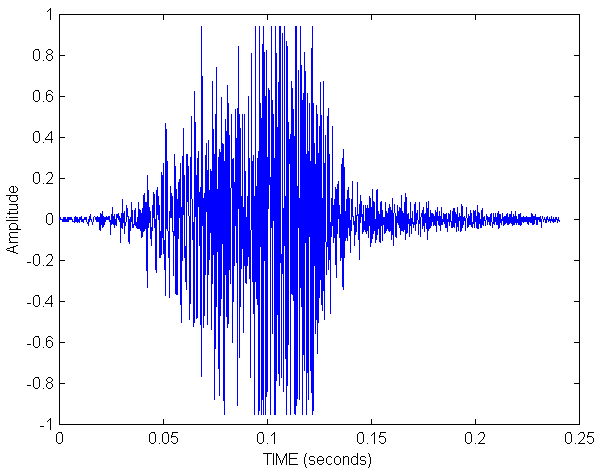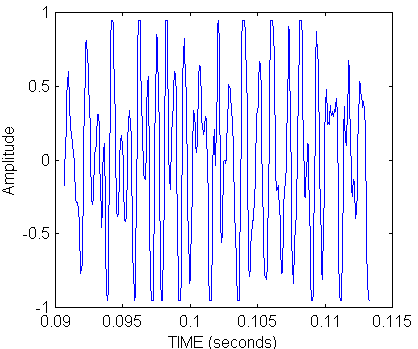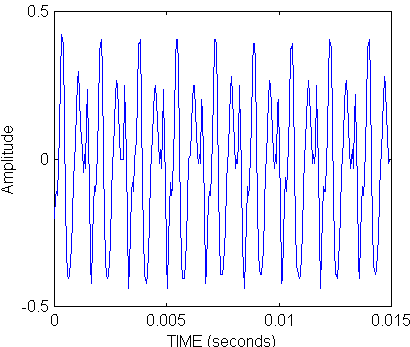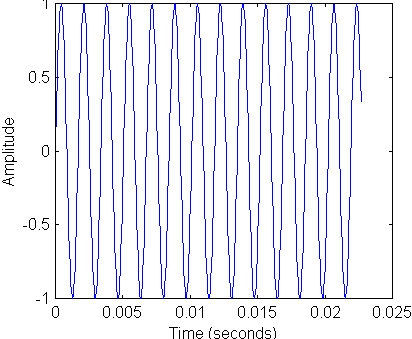Sounds and Tones (Pure and Complex)
The purpose of this section is to distinguish between musical tones and sounds. I also want to make a further distinction between two types of musical tone, so-called simple and complex tones. To accomplish these objective we will be listening to sounds and examining their digitized wave forms in the time domain. As we will see in subsequent sections we can also examine the properties of sounds in the frequency domain--the extra insight given by examining the frequency spectrum is the basic objective of this entire module.
Lets begin by considering the following sound. Listen to the sound, it should be readily recognizable.
Here is a plot of the wave form that you've just heard. The horizontal axis is time in seconds and the vertical axis is the amplitude of the digital signal. I know that the signal is clipped in the center, but my dog got disgusted with me and walked off before I could get a better recording. I think she is after milkbone residuals for the use of her voice.

A dog's bark is certainly a recognizable sound but you would not classify it as a musical tone. Oh, I know around December we will get those records of Christmas Music done by barking dogs, but that's just an aberration created in the warped minds of tonally-challenged marketing people. The real quastion is, what is it that makes a sound have musical qualities? To answer that let's first look more closely at a small segment of the above dog bark waveform.

In this expanded view (note how the time axis relates to the first figure above) we can see the real variations with time of the signal. What I want you to notice is that there is norepeated patternin the waveform. There are a lot of peaks, however, the spacing between peaksalong the time axisis not uniform.
Let's contrast this finding for the sound of the dog's bark with the recording of a musical tone. Here is the musical tone:
Yes, it's just little old me playing a shaky note on the harmonica. I won't plot the whole waveform, instead, in the graph below, I plot a detail of a small piece of the waveform.

Note the difference here compared to the dog bark. There is arepeated pattern as a function of time. How many times does the pattern repeat in the 0.015 seconds plotted here? Be careful--counting the upper peaks is easier because in the negative direction there are two different peaks for each iteration, one sharp and the other rounded. I count 8 complete repeats of the pattern and the 9th is almost complete. Lets call it 8.9 repeats of the pattern in 0.015 seconds.
Self Test
Using the information from the last paragraph:
- What is the period for one complete oscillation of the wave?
- What frequency does this period correspond to?
- What musical note does this frequency come closest to? (See the text book on page 179 for the frequency of the notes of the tempered scale).
Pure and Complex Tones
We saw in the example of the harmonica note that the time-domain waveform is periodic with time. The period corresponds to a frequency that we assign to the note D5, which is in fact the note I was playing on my faithful Hohner Special 20. You might be tempted to say "This is easy, the frequency of the wave form corresponds to the note". Ah but things are never that simple. The frequency of 593 Hz that you should have derived from the plot of the harmonica waveform is not the only frequency present in the signal! How can I say this. Well if theonlyfrequency in the signal was 593 we would have a wave form that looked like this:

It would be a pure sine wave. Only the pure sine wave has a single frequency associated with it. The harmonica waveform has a lot of other erratic peaks and dips and it does not look anything like the pure sine. The fact is that in addition to the frequency of 593 Hz there are a number of other frequencies all added together to give the non-sinusoidal shape of the harmonica wave form. The nature of all of these other frequencies, and their relationship to the fundamental periodicity of the wave, is crucial to understanding musical acoustics and we will be seeing in subsequent sections just how we can untangle the wave form to determine what other frequencies are there and how much of each comprise the complex waveform.
From the discussion you should understand the differences between a pure tone, a complex tone and a sound:
- a pure tone consists of only a single frequency. It's wave form is a pure sine wave.
- A complex tone is not a pure sine wave but it is periodic--it has an underlying pattern that repeats.
- A sound may have a pattern that looks pretty much the same each time it occurs (one dog bark sounds pretty much like any other); however, within the wave form there is no long term discernable pattern.
Send me an email at wroberts@mtsu.edu
Contact Information
Dr. W. M. Robertson
MTSU Box X-116
Murfreesboro, TN 37132
Ph. (615) 898-5837


